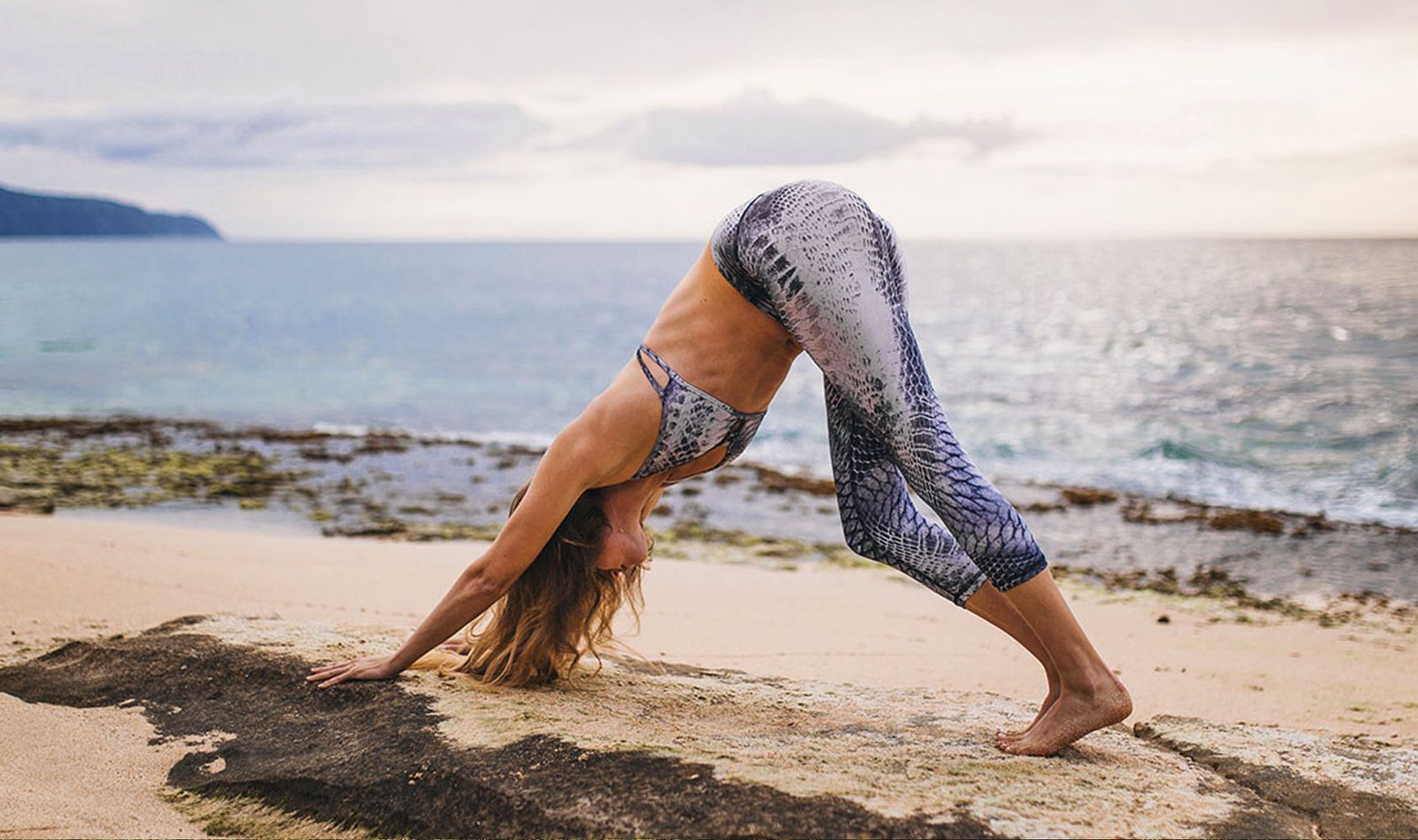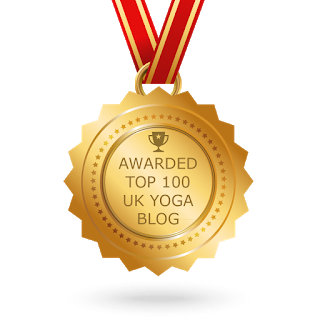Nothing can wake our hamstrings up quite as well as a thorough forward bend. It could be a standing or sitting pose, and even an inversion. But what is it exactly that happens in our body and mind when we bend forward, and how can we perfect getting there?
Benefits
Bending forward is a popular way in yoga for calming and soothing the mind as well as the entire nervous system. It helps turn the attention inward and is often prescribed for insomnia to conquer racing thoughts.
On the physical level, it’s all about stretching out the tightness at the back of our body – from the soles of the feet to the calves and thighs to the back of the hips and the back itself. A powerful forward bend can even open the shoulders and gently stretch the ligaments between the spinal vertebrae. Creating this extra space in the spine often comes as a blessing in the lower back area – which may suffer from habitual excessive compression.
A deep yoga work that brings real results starts, however, with the right attitude. We might feel tempted to fold as deeply as we possibly can to match what other yogis can do, but then we risk pushing ourselves too far. Therefore, our mind should start with a non-competitive approach, welcoming small, seemingly insignificant, details and adjustments.
Top Tips for Safe Forward Bending
Perhaps our bad habits started as early as in childhood, or while paying little attention to physical education classes at school. Perhaps, back then, we desperately tried to bring our face towards our own legs in forward bends believing this is the best way to really get that stretch. But by focusing on bringing the head first we tend to forget about the alignment of the spine, and so, often bending at the waist. This results in a rounded back and excessive compressions on the edges of our vertebrae.
Certain yoga posture names are not helping either – names such as “Head to knee” create images in the mind that can bring potentially risky consequences in the future. The actual instruction in most forward bends is to bring the chest, or heart, towards the legs or knees. This allows us to bend from the hips, and not from the waist, lengthening the spine and perhaps even inviting us to engage the abdominal muscles to protect the lower back and strengthen the core.
Another common misconception in forward bends in yoga is the need to keep the legs straight at all times. Yet, not all of us have the hamstrings stretched enough to be able to perform this without a real struggle. The point of bending forward is to work on our hamstrings, too. But more important than that is our lower back, and it will often benefit from our knees being slightly bent. This will also protect the knees from hyperextending.
Advanced Forward Bend: Big Toe Pose
Yoga offers a variety of standing-forward bends. For example, the Big toe pose (padangusthasana), in which we bend forward while standing, reaching out with our fingers towards the big toes, is a symmetrical pose allowing us to identify asymmetries and imbalances between the two sides of our body.
Warm-up
Many asanas in yoga look easy to teach and perform – with a set of quick instructions. But a well-designed yoga session will let us go into a full pose only after a dedicated preparation for both body and mind. Preparation is actually essential for a minimised chance of injuries and working within the body's limits, as well as deepened concentration and awareness.
The warm-up can start with a short breathing-focused meditation followed by head and neck rolls synchronised with the breath. Once inhales automatically guide our movements, we can move into Mountain pose, eventually lowering down from the hips into a table-top flat back position. Alternatively, we could try Skier pose and let it finish in a gentle forward bend, releasing the tension from the upper back and neck first.
Moving into a more intense preparation, we can consider Downward-facing dog (adho mukha svanasana) to stretch the arms, shoulders, hamstrings and calves. Standing forward bend (uttanasana) could be our next step – it stretches the hips, hamstrings and calves, as well as strengthens the thighs and knees. The inward focus – for example on the breath – should be maintained here to make the practice a mindful one as well.
Benefits
A variety of benefits of the Big toe pose include headache, insomnia, stress and anxiety relief, as well as liver, kidneys and digestion stimulation. And, although it’s excellent for strengthening and lengthening the muscles of the legs as well as developing spinal flexibility, it should be avoided by those with lower back or neck injuries.
Quick list of benefits:
- Stretches the hamstrings, calves, and hips
- Strengthens the thighs and knees
- Calms the brain
- Helps relieve stress and mild depression
- Reduces fatigue and anxiety
- Relieves headaches and insomnia
- Therapeutic for asthma, high blood pressure, infertility, osteoporosis, and sinusitis
- Helps relieve the symptoms of menopause
- Stimulates the liver and kidneys
- Improves digestion
Precautions & Contraindications
The best response to any recent minor back injury would be performing the pose with bent knees. Or, moving instead into Standing half forward bend (ardha uttanasana) with hands resting on a wall or piece of furniture. The pose isn't recommended for anyone with major lower back or neck injuries.
Instructions
To start off well, it might be helpful to stand in Mountain pose (tadasana), spreading the toes, allowing space between the heels, but with the big toes touching. Then, spread the weight evenly on both feet, draw the navel in, and squeeze the core. Lengthening the tailbone down brings the lower ribs together. Lifting up the chest, extending through the crown of the head, with the chin parallel to the ground. Eyes soft, shoulders back.
From here, let’s place the hands on the hips to lengthen the torso. Inhaling, bending forward from the hips, nice and slow. Now, grabbing the elbows and rocking the body from side to side. Bringing palms, or fingers, towards the floor, pressing the heels, lifting the sit bones towards the sky. Bending the knees a few times, shaking the head – ‘yes’ and ‘no’. Internally rotating the thighs to the back of the room. Inhaling, lifting and lengthening the torso. Releasing on the exhale and moving fully into the bend – the head hangs. The knees should be lifted up, and the big toes grabbed with the first two fingers and thumbs.
On the inhale, the head could go upward, with the eyes looking up, and the shoulders rolling back to stay away from the ears. The exhale, then, can deepen the stretch – pulling the toes up and the elbows bending and going to the sides. Here, the neck should extend the spine, allowing the face to rest between the shins.
This posture is recommended to be held for at least several breaths – for one minute or so. To come out of the pose, we could place the hands back on the hips, tuck the pelvis in, and lengthen the torso. Coming back up all the way to standing on the last breath in.
Extra Alignment
To increase the stretch on the backs of the legs, we could stand in the forward bend with the balls of the feet elevated an inch or more off the floor – on a sandbag or thick book.
In case of tight hamstrings and therefore rounded lower back, we can place our palms on two tall blocks several inches in front of the feet. We could also use a strap around the arches of the feet to reduce the bend on the knees if we can't reach the feet.
Counter Poses
Common forward bend counter poses are backbends and postures opening the front of the body. They can follow a forward bend straight away or after a couple of other moves – after all, the entire practice, as a whole, should be balanced. Some of the counter poses to consider could be Chair (utkatasana), Warrior I (virabhadrasana I), Crab (chatus pada pitham), Inverted plank (purvottanasana), Head stand (sirsasana), Child (balasana), and Corpse (shavasana).
Would you prefer instructions adjusted especially to your needs?
In her capacity as an independent consultant and researcher, she seamlessly integrates user, business, and technology experiences. She authored her first book in 2011 and has since emerged as a respected public speaker, delving into topics from software design and employability in the IT sector to stress reduction techniques and expedition planning in wellness. As an experienced yoga teacher committed to academic growth, Paula is on a scholarly path in religious studies, specialising in Indic traditions.
- When Monks Take Up Arms: Skilful Means as a Tactical Response to Violence in Buddhist Military Engagement - 27th December 2023
- The Role of the Jain Doctrine of Nonviolence in India - 10th November 2022
- Mahāyāna Meditation: Revered Divergence From Mainstream Buddhism - 15th January 2022


